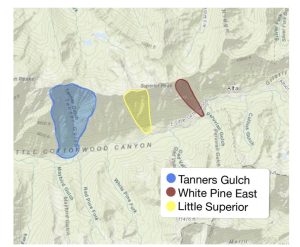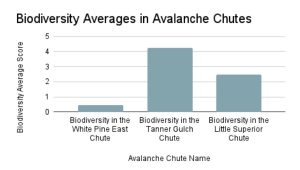College of Social & Behavioral Science
71 Avalanche Activity and Plant Biodiversity in the Wasatch Mountains, Utah
Macy Tilk (University of Utah) and Mitchell Power (Geography, University of Utah)
Faculty Mentor: Mitchell Power (Geography and Natural History Museum of Utah, University of Utah)
The Wasatch Mountains of Utah are widely known for their steep vertical relief and significant seasonal snowpack. These two factors create conditions that promote avalanche activity during winter storms. Physical factors such as temperature, snowpack depth, amount of relief and slope orientation are contributing factors for avalanche risk, however, what’s happening below the snow, to plant communities, may be just as important. Limited research has been conducted on the impact to plant diversity and how seasonal avalanche cycles may influence biodiversity over space and time. This study explores several well-known avalanche chutes to see if avalanche frequency plays a role in biodiversity. To study this, vegetation communities were studied through line transects perpendicular to avalanche paths. Species inventories were collected along each transect and were categorized into six dominant vegetation types (herb, forb, grass, shrub, juvenile tree, adult tree) to provide an index of community diversity. Maps were then created to capture the frequency of avalanches in each research site. Surprisingly, data analysis of community plant diversity in three study sites suggest that more active avalanche chutes contain higher plant diversity while less active chutes recorded lower plant diversity.
Introduction
Avalanches have a large impact on both natural and human systems. It can be consequential for plants and animals in the path and can be dangerous for humans spending time in steep terrain. Avalanches have many positive attributes through creating habitat mosaics or early- and late-succession vegetation, providing shelter and forage for a wide range of species and ultimately increasing the diversity of plants and animals. Specifically, these habitats host numerous bird and small and large mammal species, including; squirrels, bears, moose, deer and elk. Therefore it is essential to understand how disturbances by avalanches improve or decay wildlife habitat and to disentangle which ecological processes are at work. In addition to biotic factors, abiotic components, including slope angle, changing winter snowpack and snow-water content are also critical conditions impacting these systems, especially as climate change increases the frequency of avalanches. Feedbacks within avalanche prone landscapes are an additional aspect of this type of natural disturbance. For example, avalanches can shape ecosystems, including the composition of an ecosystem, which in turn, may have the ability to affect avalanche frequency, with large, old trees providing anchors and safety zones for organisms. For this undergraduate research project, I reconstructed plant diversity in avalanche chutes, through field-based line transect inventories of plant composition. Data gathered from two sites were compared to explore the impact of avalanche frequency on plant diversity. I hypothesize that biological diversity (an increased number of total tree and shrub species) is greatest in intermediate disturbed avalanche tracks and that avalanches are an agent of biodiversity.
Methods
Geographic information on avalanche frequency was used to generate study maps in Little Cottonwood Canyon. Individual avalanche chutes were broken into low, middle and high frequency for comparison on vegetation diversity. In order from least-to-most frequent avalanche activity, three sites were chosen, including; White Pine East (low), Little Superior (moderate), and Tanners Gulch (high). Data were collected by creating vegetation inventories along line transects, positioned perpendicular to avalanche paths.
Species including Symphoricarpos oreophilus, Populus tremuloides and Abies lasiocarpa were identified along the three study sites. These species were then categorized into six dominant vegetation types (herb, forb, grass, shrub, juvenile tree, adult tree) to provide an index of community diversity. Finally, data were summarized by compiling the biodiversity average score for each of the three avalanche chutes.
Surprisingly, the Tanners Gulch chute had the highest biodiversity even though it has the highest frequency of avalanches. The mechanism behind this could be linked to avalanche frequency, vegetation history, geographic location, or elevational differences in the three study sites. Clearly, more work is needed to identify contributing factors on the linkages of avalanche disturbances on plant diversity in the Wasatch Mountains.


Conclusion
This data has a wide range of applications including ecological and societal. This research was one of the first of its kind and additional work will shed light on the multiple factors influencing biodiversity in mountainous terrain. In this study, higher frequency chutes supported higher plant diversity, while the lower frequency paths had overall lower plant diversity. Plant inventory data at these fine spatial scales could help landscape managers make informed
decisions on the frequency and impacts of human-triggered avalanche control activities. Much research needs to be done in avalanche chutes to understand dominant mechanisms that influence plant and animal diversity over time, and this study provides a baseline for future analysis.

